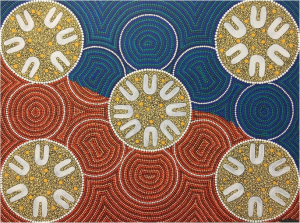
Yarning about foot care: evaluation of a foot care service for Aboriginal and Torres Strait Islander Peoples. West, M., Sadler, S., Charles, J., Hawke, F., Lanting, S., Munteanu, S., Chuter, V. J Foot Ankle Res 12:25 (2022)
This month’s focus is on a study by Matthew West and colleagues which sought to evaluate the Buridja Clinic from an Aboriginal and Torres Strait Islander perspective using culturally appropriate research methods.
We recommend reading the entire piece, which can be accessed for free here.
Almost 70% of preventable hospitalisations are due to diabetes complications for chronic conditions for Aboriginal and Torres Strait Islander Peoples, with the likelihood of diabetes-related foot disease (DFD) increased by five-fold relative to non-Indigenous Australians.
The lack of availability of culturally safe foot care services, and the effects of ongoing dispossession and distrust of Western healthcare systems, linked to institutional and historical racism, have been identified as key contributors to worse DFD in Aboriginal and Torres Strait Islander Peoples.
In 2018 the Buridja Clinic was established in the Discipline of Podiatry at the University of Newcastle, Australia, to deliver a culturally safe foot care service that is focused on DFD prevention. The aim of this study by Matthew West and colleagues was to evaluate the Buridja Clinic from an Aboriginal and Torres Strait Islander perspective using culturally appropriate research methods.
A mixed methods study took place at the Buridja clinic, whereby quantitative data was collected over a two-year period using a clinical audit. While qualitative data was gathered using weekly research yarns. Yarning is an Aboriginal and Torres Strait Islander way of storytelling, teaching and learning that is a collaborative dialogical progression. It is a research method defined as being a conversation with a purpose (with similarities to a semi-structured interview) that applies storytelling and actively listening to collecting information.
A total of 58 clinical sessions were run in the Buridja Clinic and 199 individuals attended during the testing period. The most common reasons for visiting the clinic were for general foot care (69%, n = 36), diabetes assessment (65%, n = 32), diabetes education (23%, n = 12), footwear referral (21%, n = 11), foot orthoses (10%, n = 5) and nail surgery (2%, n = 1). From the research yarns, participants reported that they were satisfied with the design of the clinic. Successful elements of the clinic related to interaction with the students, the clinical environment and improved health literacy with recognition of the clinic as helping to reduce their fears of poor health outcomes. Overall, the study found that people who attended the clinic reported improved foot health, greater foot and self-care knowledge and overall better general health and management. To read the full article, head here.

These are locations where podiatry service provision takes place. These are locations where everyone is sharing and learning. Students, teachers, patients, non-Indigenous people, and First Nations people, learning from each other, and learning from Country.
© Copyright 2021 The Australian Podiatry Association
